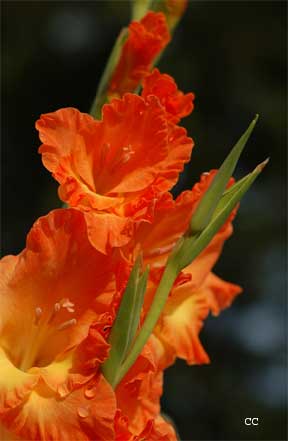For many years it was taken for granted that the gladiolus was a non-fragrant flower. The first natural impulse when one sees a flower is to smell it. As a result of this impulse some people began to detect slight odors and fragrance in certain gladiolus. Research disclosed that many of the original species used in producing our modern gladiolus were fragrant, but in selecting for size, color and form, this quality had been neglected.
The attempt to produce fragrance in gladiolus has followed two distinct methods. One group has gone hack to the fragrant species and by crossing them among themselves and on standard gladiolus. has sought to produce varieties carrying the qualities of our modern gladiolus, plus the fragrance of the species. The species Gladiolus tristis, was used in many hybrids.
The drawback to this approach to fragrance in gladiolus is that you lose much of the progress made in the last 150 years in breeding for size, color and form; as the fragrant species are small in size of floret and spike. These South African species are also Spring-flowering, like tulips, which adds to the difficulties of breeding and producing normal Summer-flowering gladiolus.

The other method of producing fragrance in gladiolus is based on the fact that many of our common varieties of gladiolus still carry recessive strains of fragrance from their original ancestors. By diligent and patient “sniffing”, these fragrant gladiolus were discovered, and began to turn up in commerce in the 1930’s.
Probably the first one to be advertised as a fragrant gladiolus was Mibloom, an early white with a red spot in the throat. Then came Incense, a small pink with yellow throat, which was widely heralded for its fragrance. It was fragrant but not much else could be said for it. Then some one discovered that New Era was slightly fragrant, as well as being a good gladiolus, and it was added to the list. Later a creamy white sport of New Era named Frilled Fragrance, was offered for sale. It was identical with New Era except in color. Summer Fragrance, a Queen of Bremen seedling, was a small ruffled rose pink with a light fragrance. Mora, a Shaylor seedling, is a light pink with a large contrasting red throat. To me this has an odor rather than a fragrance, but you definitely can smell it.
All of the above are of unknown parentage, or were chance crosses in which fragrance appeared. Among the “chance” fragrant crosses two others should probably be included. Diadem, of New Era and Vista Bonita parentage, was one of the largest in the fragrant class. It is a rose pink, but the fragrance is light and elusive. The other is Gwen, a seedling of Rose Marie Pfitzer and Meanly, is also a large rose but with a more persistent, though light fragrance.
In 1941 Brauer produced Perfume by out-crossing with Mibloom and then recrossing those seedlings. Perfume was a ruffled cream white with a rose dart in the throat and is still one of the most fragrant gladiolus in commerce.
I have over 150 selected seedlings under trial with varying amounts of fragrance.
I predict that within the next 10 years you will be selecting your new gladiolus by the type of fragrance they carry as well as by the color and size.
by OE Spencer
